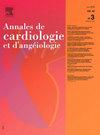TAVIGER:在评估老年患者是否符合经皮主动脉瓣置换术的条件时,协调老年病学和心脏病学专业知识的益处。
IF 0.3
Q4 Medicine
引用次数: 0
摘要
背景导管主动脉瓣植入术(TAVI)是治疗老年人主动脉瓣狭窄的金标准疗法。预先识别可能从该手术中获益的患者仍然至关重要。方法2016年至2020年间在阿拉斯医院进行的回顾性研究。结果 192(192)名患者,平均年龄 82.3 岁。TAVI 组 1 年死亡率为 18%,非 TAVI 组 1 年死亡率为 44%(P = 0.001)。2 ± 13.5,p = 0.020)、营养不良(14% vs. 35%,p = 0.004)、行走速度 < 0.8 m/s(39% vs. 75%,p = 0.001)、日常生活活动(ADL)评分(5.4 ± 1 vs. 4.2 ± 1.6, p < 0. 001)和器质性日常生活活动(IADL)评分(2.6 ± 1.2 vs. 1.8 ± 1.4, p = 0.002),迷你老年抑郁量表(mini GDS)≥ 1(16% vs. 38%,p = 0.025)。结论 老年综合征是 TAVI 候选资格的重要决定因素。心脏病手术风险评分不能有效区分患者。协调评估可优化选择。因此,作为 TAVI 术前评估的一部分,应系统地进行老年病学评估。本文章由计算机程序翻译,如有差异,请以英文原文为准。
TAVIGER : Intérêt d’une expertise coordonnée gériatrique et cardiologique dans le bilan d’éligibilité des patients âgés à un remplacement valvulaire aortique par voie percutanée
Background
Transcatheter aortic valve implantation (TAVI) is the gold standard treatment for aortic stenosis in the elderly. Pre-identification of patients likely to benefit from this procedure remains crucial. A standardised geriatric assessment is used to identify the major geriatric syndromes likely to influence postoperative outcomes.
Objective
To identify factors associated with lack of TAVI management and to compare one-year survival in TAVI vs. non-TAVI patients.
Methods
Retrospective study, between 2016 and 2020, at the Arras hospital. Patients aged 70 years and older with symptomatic severe aortic stenosis who had undergone geriatric assessment were included.
Results
One hundred and ninety-two (192) patients, mean age 82.3 years. The 1-year mortality rate was 18% in the TAVI group and 44% in the non-TAVI group (p < 0.001).
Parameters associated with no TAVI were Euroscore (ESL) 1 (19.6 ± 10.9 vs. 23.2 ± 13.5, p = 0.020), malnutrition (14% vs. 35%, p = 0.004), walking speed < 0.8 m/s (39% vs. 75%, p = 0.001), Activities of Daily Life (ADL) score (5.4 ± 1 vs. 4.2 ± 1. 6, p < 0. 001) and Instrumental Activities of Daily Life (IADL) score (2.6 ± 1.2 vs. 1.8 ± 1.4, p = 0.002), Mini Geriatric Depression Scale (mini GDS) ≥ 1 (16% vs. 38%, p = 0.045), Mini Mental State Examination (MMSE) score (25.1 ± 3.5 vs. 21.6 ± 4.3 < 0.001).
Conclusions
Geriatric syndromes are important determinants of TAVI candidacy. Cardiological surgical risk scores are not effective in discriminating between patients. Coordinated assessment may optimise selection. Therefore, geriatric assessment should be systematically performed as part of the pre-TAVI evaluation.
求助全文
通过发布文献求助,成功后即可免费获取论文全文。
去求助
来源期刊
CiteScore
0.60
自引率
0.00%
发文量
68
审稿时长
6-12 weeks
期刊介绍:
Organe scientifique de référence fondé en 1951, les Annales de cardiologie et d''angéiologie abordent tous les domaines qui intéressent quotidiennement les cardiologues et les angéiologues praticiens : neurologie et radiologie vasculaires, hémostase, diabétologie, médecine interne, épidémiologie et prévention.
Les Annales de cardiologie et d''angéiologie sont indexées aux grandes bases de données et publient rapidement, et en conformité avec les normes internationales de publication scientifique, des articles en français sur la pathologie cardiaque.

 求助内容:
求助内容: 应助结果提醒方式:
应助结果提醒方式:


